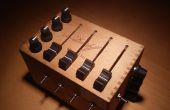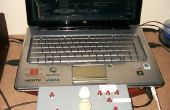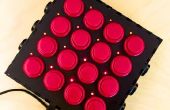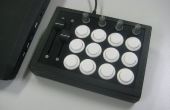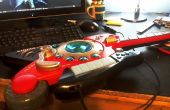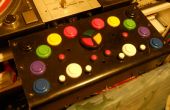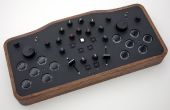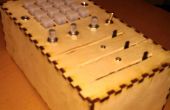Stap 10: Het uploaden van een schets aan de Arduino
Het apparaat is fysiek voltooid, alles wat overblijft is voor het laden van de code op it.below is een kopie van het Wetboek, van start tot finish, dat ik gebruikte toen ik mijn zwarte doos gebouwd. De arduino schets is ook beschikbaar als een bijlage.
<p>#define rowOne 0 // Defines the midi note played by the first row.<br>#define rowTwo 1 // Defines the midi note played by the second row. #define rowThree 2 // Defines the midi note played by the third row. #define rowFour 3 // Defines the midi note played by the fourth row. #define columnOne 2 // Defines the pin connected to the first column. #define columnTwo 3 // Defines the pin connected to the first column. #define columnThree 4 // Defines the pin connected to the first column. #define columnFour 5 // Defines the pin connected to the first column. int delayTime; // Holds the number of milliseconds the program waits between columns.</p><p>byte noteOne; byte noteTwo; byte noteThree; byte noteFour;</p><p>// Sets the pin modes for all of the inputs and outputs of the arduino</p><p>void setup() { pinMode(7, INPUT); pinMode(8, INPUT); pinMode(9, INPUT); pinMode(10, INPUT); pinMode(11, INPUT); pinMode(12, INPUT); digitalWrite(12, HIGH); pinMode(columnOne, OUTPUT); pinMode(columnTwo, OUTPUT); pinMode(columnThree, OUTPUT); pinMode(columnFour, OUTPUT); }</p><p>void loop() { setDelay(); flashColumn(columnOne); flashColumn(columnTwo); flashColumn(columnThree); flashColumn(columnFour); if(digitalRead(12) == 0){ playTimingNotes(); } else { playNormalNotes(); delay(delayTime); } noteOne = 0; noteTwo = 0; noteThree = 0; noteFour = 0; }</p><p>// First parameter is the event type (0x09 = note on, 0x08 = note off). // Second parameter is note-on/note-off, combined with the channel. // Channel can be anything between 0-15. Typically reported to the user as 1-16. // Third parameter is the note number (48 = middle C). // Fourth parameter is the velocity (64 = normal, 127 = fastest).</p><p>void noteOn(byte channel, byte pitch, byte velocity) { MIDIEvent noteOn = {0x09, 0x90 | channel, pitch, velocity}; MIDIUSB.write(noteOn); }</p><p>void noteOff(byte channel, byte pitch, byte velocity) { MIDIEvent noteOff = {0x08, 0x80 | channel, pitch, velocity}; MIDIUSB.write(noteOff); }</p><p>// Combines note on and note off information into one method</p><p>void playNote(byte channel, byte pitch, byte velocity){ noteOn(channel, pitch, velocity); MIDIUSB.flush(); noteOff(channel, pitch, velocity); MIDIUSB.flush(); }</p><p>// Powers a column of the matrix, then reads out which switches are closed // then sets the column back down to low</p><p>void flashColumn(byte column){ digitalWrite(column, HIGH); readColumn(column); digitalWrite(column, LOW); }</p><p>// Reads each row, then plays the respective notes if the switches are closed</p><p>void readColumn(int column){ int noteNumber = 100; if(digitalRead(8) == 1){ noteNumber = rowOne + (column-1)*12; } else if(digitalRead(9) == 1){ noteNumber = rowTwo + (column-1)*12; } else if(digitalRead(10) == 1){ noteNumber = rowThree + (column-1)*12; } else if(digitalRead(11) == 1){ noteNumber = rowFour + (column-1)*12; } if(column == 2){ noteOne = noteNumber; } else if(column == 3){ noteTwo = noteNumber; } else if(column == 4){ noteThree = noteNumber; } else if(column == 5){ noteFour = noteNumber; } }</p><p>void playTimingNotes(){ for(int i = 0; i < 4; i++){ playNote(0, 100, 64); delay(delayTime/32); } }</p><p>void playNormalNotes(){ if(noteOne != 0){ playNote(0, noteOne, 64); } if(noteTwo != 0){ playNote(0, noteTwo, 64); } if(noteThree != 0){ playNote(0, noteThree, 64); } if(noteFour != 0){ playNote(0, noteFour, 64); } }</p><p>void setDelay(){ delayTime = ((analogRead(A0)/2)+300)*32; }</p>
